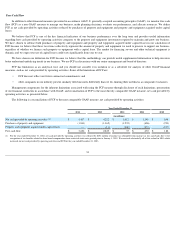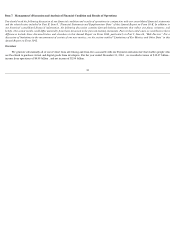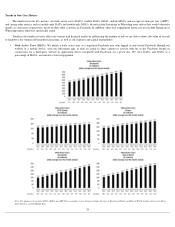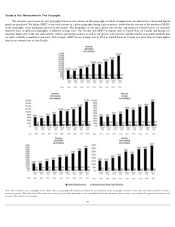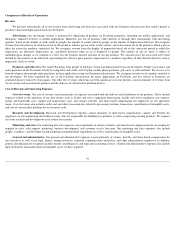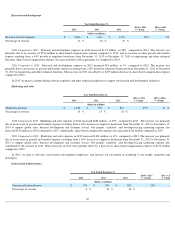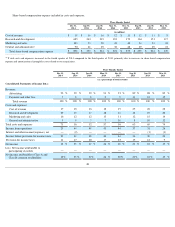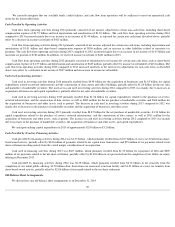Facebook 2014 Annual Report Download - page 44
Download and view the complete annual report
Please find page 44 of the 2014 Facebook annual report below. You can navigate through the pages in the report by either clicking on the pages listed below, or by using the keyword search tool below to find specific information within the annual report.
Components of Results of Operations
Revenue
We generate substantially all of our revenue from advertising and from fees associated with our Payments infrastructure that enables people to
purchase virtual and digital goods from our developers.
Advertising.
Our advertising revenue is generated by displaying ad products on Facebook properties, including our mobile applications, and
third-
party affiliated websites or mobile applications. Marketers pay for ad products either directly or through their relationships with advertising
agencies, based on the number of clicks made by people, the number of actions taken by people, or the number of impressions delivered. We recognize
revenue from the delivery of click-based ads in the period in which a person clicks on the content, and action-
based ads in the period in which a person
takes the action the marketer contracted for. We recognize revenue from the display of impression-
based ads in the contracted period in which the
impressions are delivered. Impressions are considered delivered when an ad is displayed to people. The number of ads we show is subject to
methodological changes as we continue to evolve our ads business and the structure of our ads products. We calculate price per ad as total ad revenue
divided by the number of ads delivered, representing the effective price paid per impression by a marketer regardless of their desired objective such as
impression, click, or action.
Payments and other fees.
We enable Payments from people to purchase virtual and digital goods from our developers. People can transact and
make payments on the Facebook website by using debit and credit cards, PayPal, mobile phone payments, gift cards, or other methods. We receive a fee
from developers when people make purchases in these applications using our Payments infrastructure. We recognize revenue net of amounts remitted to
our developers. We have mandated the use of our Payments infrastructure for game applications on Facebook, and fees related to Payments are
generated almost exclusively from games. Our other fees revenue, which has not been significant in recent periods, consists primarily of revenue from
our ad serving and measurement products and the delivery of virtual reality platform devices.
Cost of Revenue and Operating Expenses
Cost of revenue.
Our cost of revenue consists primarily of expenses associated with the delivery and distribution of our products. These include
expenses related to the operation of our data centers such as facility and server equipment depreciation, facility and server equipment rent expense,
energy and bandwidth costs, support and maintenance costs, and salaries, benefits, and share-
based compensation for employees on our operations
teams. Cost of revenue also includes credit card and other transaction fees related to processing customer transactions, amortization of intangible assets,
and cost of virtual reality platform device inventory sold.
Research and development. Research and development expenses consist primarily of share-
based compensation, salaries and benefits for
employees on our engineering and technical teams who are responsible for building new products as well as improving existing products. We expense
all of our research and development costs as they are incurred.
Marketing and sales. Our marketing and sales expenses consist primarily of salaries, benefits, and share-
based compensation for our employees
engaged in sales, sales support, marketing, business development, and customer service functions. Our marketing and sales expenses also include
people-, marketer-, and developer-facing marketing and promotional expenditures as well as amortization of intangible assets.
General and administrative. Our general and administrative expenses consist primarily of salaries, benefits, and share-
based compensation for
our executives as well as our legal, finance, human resources, corporate communications and policy, and other administrative employees. In addition,
general and administrative expenses include outside consulting fees, and legal and accounting services. General and administrative expenses also include
legal settlements and amortization of intangible assets we have acquired.
41


